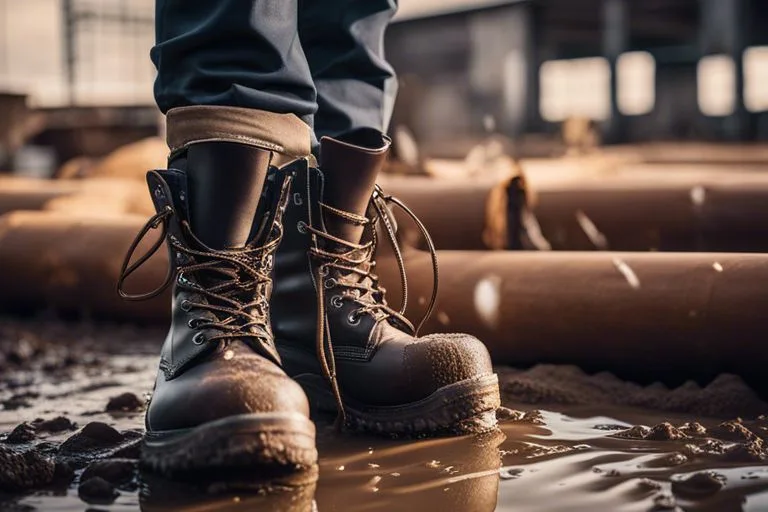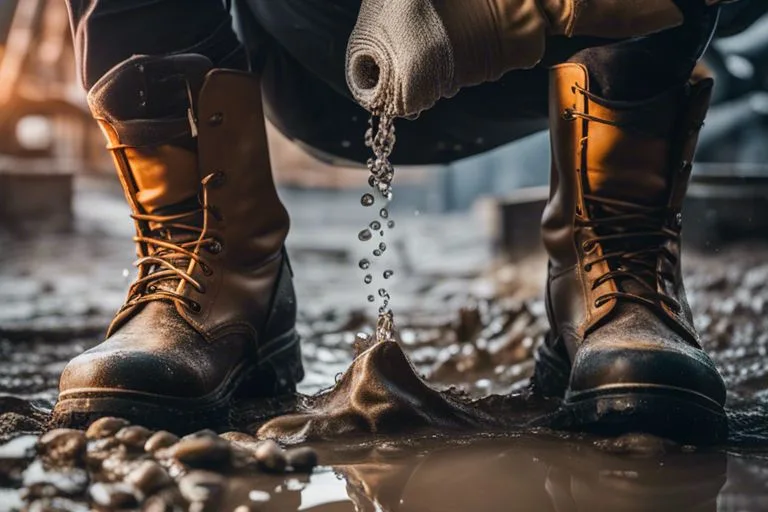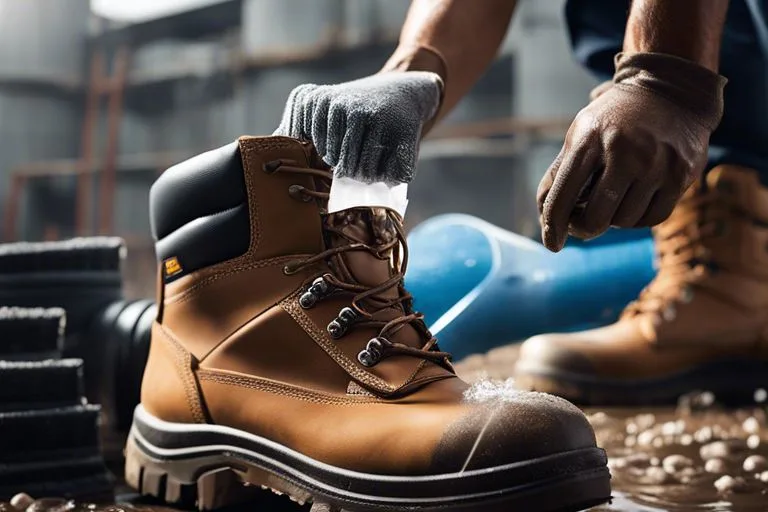You may have experienced the discomfort of having wet feet while working in your boots. Not only is it uncomfortable, but it can also lead to potentially dangerous situations such as blisters, infections, and even trench foot. To prevent these problems, it’s important to take the necessary steps to keep your feet dry while wearing work boots. One of the most important factors in keeping your feet dry is choosing the right pair of boots. Look for waterproof or water-resistant boots made of durable, breathable materials to help keep moisture out while allowing sweat to escape. Additionally, it’s essential to wear moisture-wicking socks that can help pull sweat away from your feet and keep them dry throughout the day.
Key Takeaways:
- Invest in moisture-wicking socks: Look for socks made from merino wool or synthetic materials designed to wick moisture away from the skin, keeping your feet dry and comfortable.
- Choose breathable work boots: Opt for work boots with breathable materials such as mesh or Gore-Tex to allow for better air circulation and prevent sweat buildup.
- Use foot powder or anti-perspirant: Apply foot powder or anti-perspirant before putting on your work boots to help absorb moisture and reduce sweat production.
Understanding the Causes of Wet Feet
While it may seem like a nuisance, having wet feet in work boots can lead to a variety of issues. Understanding the causes of this problem can help you take preventative measures to keep your feet dry and comfortable throughout the day.
External Sources of Moisture
External sources of moisture, such as rain, snow, or standing water, are some of the most obvious culprits when it comes to wet feet in work boots. If your job requires you to work outdoors or in wet environments, it’s essential to choose work boots that are not only waterproof but also have proper insulation to keep your feet dry and warm. Additionally, make sure to inspect your work boots for any cracks, holes, or other signs of damage that could allow moisture to seep in. When selecting work boots, look for those with strong waterproofing materials and durable construction to ensure they can withstand external sources of moisture.
Internal Sources: Sweating and Breathability Issues
Another common cause of wet feet in work boots comes from internal sources, such as sweating and breathability issues. When your feet sweat, especially in a confined space like a work boot, it can create a moist environment that leads to discomfort and potentially even fungal or bacterial infections. Look for work boots that have breathable materials and moisture-wicking linings to help prevent sweat from accumulating inside your boots. Additionally, choosing work boots with proper ventilation can help promote airflow and reduce the likelihood of moisture buildup.
Choosing the Right Work Boots
Assuming you want to keep your feet dry in your work boots, choosing the right pair is essential. There are several factors to consider when selecting work boots that will keep your feet dry and comfortable throughout the workday.
Materials and Construction
When choosing work boots to keep your feet dry, pay close attention to the materials and construction. Look for boots made of waterproof materials such as Gore-Tex, rubber, or treated leather. These materials are designed to repel water and keep your feet dry even in the harshest conditions. Additionally, consider the construction of the boots. Look for well-sealed seams and a gusseted tongue to prevent water from seeping in through the boot’s openings.
Waterproof vs. Water-Resistant Boots
It’s important to understand the difference between waterproof and water-resistant boots when selecting work boots to keep your feet dry. Waterproof boots are designed to keep water out even in the most extreme conditions, while water-resistant boots can only withstand light moisture. If you work in a consistently wet environment, opt for waterproof boots to ensure maximum protection for your feet. However, if you only encounter occasional light rain or moisture, water-resistant boots may suffice.
Maintenance and Care of Work Boots
Not only is it important to keep your feet dry while wearing work boots, but it’s also crucial to properly maintain and care for your boots to ensure they continue to provide the protection and comfort you need. By following simple maintenance and care practices, you can extend the lifespan of your work boots and keep your feet dry and comfortable throughout the workday.
Cleaning and Drying Techniques
One of the most important aspects of maintaining dry feet in work boots is to regularly clean and dry your boots. After each use, remove any excess dirt and debris from your boots using a stiff brush. This will prevent the buildup of grime and allow your boots to breathe properly. Additionally, thoroughly dry your boots after each use, especially if they have become damp or wet. Stuffing them with newspaper can help absorb moisture and speed up the drying process. Never place your boots near direct heat sources, as this can cause damage to the material.
Waterproofing Treatments and Products
Applying waterproofing treatments to your work boots can significantly help in keeping your feet dry. There are various waterproofing products available, including sprays, waxes, and creams, that can effectively repel water and prevent moisture from seeping into your boots. Be sure to follow the manufacturer’s instructions when applying these products, and reapply as necessary depending on the frequency of use and exposure to wet conditions. You can also consider investing in waterproof work boots that come pre-treated with waterproofing technology for added protection against moisture.
Enhancing Boot Breathability
For proper breathability in work boots, you can take several steps to enhance the ventilation and air circulation inside your footwear. This will help to prevent the buildup of moisture and keep your feet dry throughout the workday. To learn more about how to keep your feet dry in wet shoes, check out this How to keep your feet dry in wet shoes.
Using Breathable Liners and Inserts
One way to enhance the breathability of your work boots is to invest in breathable liners and inserts. These are specifically designed to wick away moisture from your feet and provide better ventilation inside the boots. Look for liners and inserts made from moisture-wicking materials such as polyester or merino wool. These materials are effective at drawing moisture away from your skin, keeping your feet dry even during long hours of wear. Additionally, some liners are equipped with antimicrobial properties to prevent the growth of odor-causing bacteria, keeping your boots fresh and comfortable.
Opting for Boots with Moisture-Wicking Properties
When shopping for work boots, prioritize those with moisture-wicking properties. These boots are engineered to actively pull moisture away from your feet and promote evaporation, keeping your feet dry and comfortable. Look for boots with breathable and quick-drying materials such as Gore-Tex or other waterproof yet breathable membranes. Additionally, some boots are designed with built-in ventilation systems or mesh panels to enhance air circulation. By choosing boots with these features, you can significantly reduce the likelihood of discomfort and potential foot issues caused by excessive moisture buildup.
Personal Foot Care
Keep your feet dry and healthy by taking care of them both inside and outside of your work boots. By prioritizing personal foot care, you can prevent moisture buildup and keep your feet comfortable during long workdays.
Importance of Hygiene
Proper foot hygiene is essential for keeping your feet dry in work boots. When sweat and moisture accumulate, it creates the perfect environment for bacteria and fungi to thrive, leading to foot odor, infections, and discomfort. To maintain good foot hygiene, make sure to wash your feet daily with soap and water, paying extra attention to areas between the toes. After drying your feet thoroughly, apply a foot powder or antiperspirant to help absorb moisture and reduce sweating. Additionally, consider using antifungal sprays or creams to prevent fungal growth and maintain overall foot health.
Socks: Materials and Fit
The type of socks you wear can significantly impact the dryness of your feet in work boots. Opt for moisture-wicking and breathable materials such as merino wool or synthetic fibers to keep your feet dry throughout the day. Avoid cotton socks, as they tend to retain moisture and can contribute to sweaty, uncomfortable feet. Proper sock fit is also crucial – make sure your socks are not too tight, as this can restrict blood flow and contribute to moisture buildup. Look for seamless and cushioned socks that provide comfort and minimize friction, reducing the risk of blisters and hot spots during long work hours.
Utilizing Additional Accessories
Despite wearing moisture-wicking socks and breathable work boots, sometimes your feet may still end up damp at the end of a long day. In such cases, utilizing additional accessories can help keep your feet dry and comfortable, ultimately preventing issues such as blisters and fungal infections.
Moisture-Absorbing Foot Powders
One of the most effective ways to keep your feet dry is by using moisture-absorbing foot powders. These powders are designed to absorb sweat and moisture, keeping your feet dry and reducing the likelihood of unpleasant odors. Before putting on your work boots, sprinkle some foot powder into them and make sure to evenly distribute it. Additionally, you can also apply some directly onto your feet before putting on your socks. Not only will this help keep your feet dry, but it can also prevent friction and chafing, ultimately reducing the risk of blisters.
Boot Dryers and Deodorizers
If your work boots tend to retain moisture even after being aired out, investing in a boot dryer can make a significant difference. These devices are designed to gently dry out your boots, ensuring that they are completely moisture-free before your next wear. This not only helps keep your feet dry but also prolongs the life of your work boots by preventing the growth of mold and bacteria. Additionally, consider using deodorizers to eliminate any unpleasant odors that may have developed in your work boots. These can help maintain a fresh and pleasant environment for your feet.

When to Replace Work Boots
Unlike your favorite pair of sneakers, work boots are subjected to much harsher conditions and wear and tear. Knowing when to replace your work boots is crucial to maintaining dry and comfortable feet. Ignoring the signs of worn-out work boots can lead to discomfort, blisters, and even injury. Here are some key indicators that it’s time to replace your work boots.
Recognizing Signs of Wear that Affect Dryness
One of the most obvious signs that your work boots need replacing is when they no longer keep your feet dry. If you find that your feet are getting wet, even in mildly damp conditions, it’s a clear indication that the waterproofing or insulation in your boots has worn down. Additionally, if you notice any cracks, tears, or holes in the material of the boots, it’s time for a replacement. Another sign of wear is when the tread on the outsole has worn down significantly, leading to reduced traction and potentially causing slips and falls, putting you at risk of injury. Pay attention to any discomfort or soreness in your feet and legs as well, as it could be a result of worn-out support and cushioning in your boots.
The Lifecycle of a Work Boot: Durability vs. Performance
Understanding the lifecycle of a work boot is essential for knowing when to replace them. While it’s tempting to hang on to your favorite pair of work boots as long as possible, it’s important to realize that, over time, the materials and construction of the boots will degrade, compromising their performance and safety features. The more you use your work boots, the faster they will wear out. Factors such as the type of work you do, the environment you work in, and how well you care for your boots all play a role in their longevity. Regularly inspecting your work boots for signs of wear and tear will help you determine the right time to replace them.
Knowing when to replace your work boots is crucial for maintaining dry, comfortable, and safe conditions for your feet. Keep a close eye on the signs of wear, and listen to your body for any discomfort or pain that could be a result of worn-out boots. Remember, your work boots are your most important tool for keeping your feet protected, so invest in a new pair when the time comes.
 1. Choose waterproof work boots with high-quality materials.
1. Choose waterproof work boots with high-quality materials.
2. Wear moisture-wicking socks to keep feet dry.
3. Allow boots to fully dry out between uses.
4. Use waterproofing sprays or treatments on boots.
5. Keep feet dry by avoiding deep puddles and wet surfaces.
6. Consider using moisture-absorbing insoles for added protection.
Conclusion
To wrap up, keeping your feet dry in work boots is essential for comfort and overall foot health. By investing in high-quality waterproof work boots, using moisture-wicking socks, and regularly applying waterproofing products, you can effectively keep your feet dry and protected from water and moisture. Additionally, making sure to keep your work boots clean and dry after each use will also help in preventing moisture from building up inside the boots. By following these tips, you can ensure that your feet stay dry and comfortable throughout your workday.
Overall, prioritizing keeping your feet dry in work boots not only improves your comfort but also helps in preventing foot problems such as blisters, athlete’s foot, and other infections. By taking proactive measures and investing in the right footwear and accessories, you can maintain dry, healthy feet even in challenging work environments.
FAQ
Q: Why is it important to keep feet dry in work boots?
A: Keeping feet dry in work boots is important to prevent discomfort, reduce the risk of infections such as athlete’s foot, and maintain overall foot health.
Q: What are some tips for keeping feet dry in work boots?
A: Wear moisture-wicking socks, use breathable and waterproof work boots, and apply foot powders or antiperspirants to reduce sweating.
Q: How often should work boots be inspected for moisture buildup?
A: Work boots should be inspected daily for any signs of moisture buildup. It is important to address and remedy any issues promptly to prevent discomfort and potential foot health issues.
Q: Can I use waterproofing sprays or treatments on my work boots?
A: Yes, waterproofing sprays or treatments can be used on work boots to help repel water and keep feet dry. Follow the manufacturer’s instructions for best results.
Q: What should I do if my work boots become wet?
A: If your work boots become wet, ensure they are thoroughly dried before wearing them again. Remove any insoles and allow both the boots and insoles to air dry. Avoid wearing damp boots to prevent discomfort and the risk of foot health issues.

